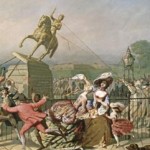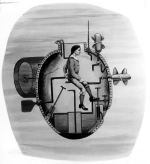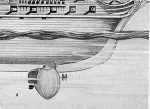On the morning of July 9, messengers from Philadelphia crossed the Hudson with a document for the Commander-in-Chief of the Revolutionary army. Five days before, Congress had approved a clear policy statement that coincidentally clarified his personal position. Until now he had been a rebel. Now he was a traitor.
The Commander-in-Chief ordered that six long-hand copies of the document be made and distributed to his brigade commanders. Then he ordered Retreat—the military ceremony ending the day—for 6:00 p.m., a half-hour earlier than usual. Most of his troops were bivouacked in the rolling wooded hills of what is now midtown. Their ceremonies would be held wherever brigade commanders could find sufficiently large, flat, open spaces.
The two brigades encamped in the city proper were ordered to form on the Common—from roughly the south end of City Hall Park to the intersection of Broadway and Park Row. By 5:30, the Common was a chaos of dust, marching regiments, bellowed orders, rolling drums, and piercing fifes. The adjoining streets were full of civilians, drawn by the stir.
The Commander-in-Chief swung into the saddle shortly before six for a brief ride to the Common. He was in his mid-forties, a big man, about 210 pounds and six feet-two inches tall. From early manhood, as Bruce Bliven Jr. wrote, his tremendous natural presence had made him “a man people looked to when he was in the room.” His face was ruddy, with the clear, pale skin that burns rather than tans. He was remarkably strong and, except for his teeth, in fine health. He was so broad-shouldered that his uniform coats needed no padding. He sat easily and gracefully in the saddle: he was, as a fellow Virginian, Thomas Jefferson, said, “the finest horseman on the continent.”
He rode into the hollow square of men amid a cacophony of shouting as the company officers reported to their regimental commanders, the regimental commanders to the brigade commanders, and the brigade commanders to the Commander-in-Chief that all men were present or accounted for. “Then the formation was ordered to stand at ease,” Bliven wrote in Under the Guns, “and it was quiet.”
He habitually wore an assumed expression of good-humored reserve. This was in part due to physical discomfort—his teeth hurt—but more to force of habit. He consciously worked to conceal his emotions and generally succeeded (Bliven notes in Battle for Manhattan that the Commander-in-Chief was naturally passionate and hot-tempered). At worst, he sometimes showed irritation by withdrawing into an icy, impenetrable formality.
Only a few, such as General Charles Lee, whom the Commander-in-Chief would personally relieve of command on the battlefield after Lee’s bungling the Battle of Monmouth, would taste the extraordinary, almost terrifying rage coiled within George Washington: the sudden flush, the calm features contorted with contempt and anger, the narrowed blue eyes turned to slate, the grating roar of the voice, so rarely raised above a conversational tone, and the savage words striking like the butt end of a bullwhip.
 But this was not such a day. The ceremonies opened with routine announcements: the Commander-in- Chief approved sentences of flogging passed by court-martial against two deserters; the form of the passes for the Hudson River ferries had changed; the Congress had authorized each regiment to have its own chaplain and pay him thirty-three-and-a-third dollars a month.
But this was not such a day. The ceremonies opened with routine announcements: the Commander-in- Chief approved sentences of flogging passed by court-martial against two deserters; the form of the passes for the Hudson River ferries had changed; the Congress had authorized each regiment to have its own chaplain and pay him thirty-three-and-a-third dollars a month.
Then an aide-de-camp declaimed the document from Philadelphia:
When in the Course of human Events…We hold these Truths to be self-evident, that all Men are created equal, that they are endowed by their Creator with certain unalienable Rights, that among these are Life, Liberty, and the pursuit of Happiness…that when any Form of Government becomes destructive of these Ends, it is the Right of the People to alter or to abolish it…it is their Right, it is their Duty, to throw off such Government…A Prince whose Character is thus marked by every act which may define a Tyrant, is unfit to be the Ruler of a free people…And for the support of this declaration, with a firm Reliance on the protection of divine Providence, we mutually pledge to each other our lives, our Fortunes, and our sacred Honor.”
The chaplain read from the Eightieth Psalm; the brigades gave three cheers; and the troops were dismissed. That night, a mob quietly toppled the gilt-lead statue of King George III at Bowling Green, where the fountain is now, and broke it into sections small enough to cart away for melting into shot.
From contemporary descriptions of his looks and personality, David Bushnell was probably a nerd. He sold his share of the family farm to pay his tuition at Yale College. From his arrival as a thirty-one-year-old freshman, Bushnell studied the Transactions of the Royal Society and other scientific journals in the library. His obsession was solving a particular problem: detonating explosives under water.
By 1773, he had succeeded. Dr. Benjamin Gale observed him place two ounces of gunpowder in a container, which Bushnell then submerged and detonated. Before graduating in 1775, he had devised a bomb, which he called a “powder magazine.” Two hollowed blocks of oak, bound with iron bands, contained 150 pounds of gunpowder. When an adjustable clockwork timer ran down, it released a gunlock “with a good flint” to detonate the bomb. The device was buoyant, to float up against the bottom of its target.
Now Bushnell turned to the means of delivering the bomb. Apparently this was much easier. Over the summer of 1775, he designed and built the world’s first working submarine.
The Turtle was 7 1/2 feet long, 6 feet high, and built of oak in the shape of an egg or a clam, bound with iron bands, the seams caulked, and “the whole smear’ d over with tar.” The conning tower was made of metal, with a hinged door and eight small windows of thick glass, each about the size of a half-dollar. When afloat, it was nearly awash. Once under water, it could be navigated by compass. Both compass and depth gauge were illuminated by fox fire: phosphorescent wood.
She moved with three crank-driven pair of oars, “crossed like a windmill,” that drove the boat forward and back, up and down, and to port and starboard. Her operator could make as much as three knots by vigorously turning the crank. When the operator wanted to submerge, he pressed a spring-operated valve, opening a seacock that admitted water into a ballast tank. To surface, he expelled the water by pedaling a pump with his feet.
 When on the surface, a ventilator admitted fresh and expelled stale air. Its valves automatically closed as the boat submerged and opened as she surfaced. When submerged, the operator had about a half-hour’s supply of oxygen.
When on the surface, a ventilator admitted fresh and expelled stale air. Its valves automatically closed as the boat submerged and opened as she surfaced. When submerged, the operator had about a half-hour’s supply of oxygen.
The powder magazine was carried on the Turtle‘s back. Once the submarine had reached its target, the operator used a crank-operated drill to hole the ship’s underwater planking. The drill then inserted a screw into the hole. The screw, in turn, was linked to the bomb.
Now the ship needed a crew. Sergeant Ezra Lee, from Lyme, Connecticut volunteered and Bushnell trained him, while the British seized Staten Island, Long Island, and Governor’s Island. In late July, 1776, the Turtle was carted overland to the Hudson. The time had come.
On a calm August night, Lee began history’s first submarine combat mission. Off Whitehall Stairs, near the Battery, he entered the craft, the hatch was clamped tight, and he cast off, setting out to sink Lord Howe’s flagship, H.M.S. Eagle.
Few warships have set forth “so open to fatal accident,” as Stewart Holbrook wrote in Lost Men of American History. He summarized Lee’s situation: “…should a leak start, the operator could do little but drown where he was, for he was clamped in from outside. A floating log might break one of the eight windows. A good stiff jolt could set off the devilish infernal machine that rode on the Turtle‘s back.”
The ebbing tide pulled Lee past the British fleet and toward the open sea. He cranked furiously to bring her about and then, against the tide, back to the fleet. It took two-and-a-half hours.
In the darkness, to a man seeing her from six inches above the water, the Eagle seemed gigantic. Lee glided to her stern, opened the seacock, and submerged. He felt the Turtle rubbing against the man-of-war. Save for the foxfire glowing on his compass and depth gauge, Lee was in utter darkness. He began drilling into the Eagle’s hull.
Within a few seconds, Lee realized the drill wasn’t penetrating the ship. Unbeknownst to him, the Eagle’s bottom had been sheathed with copper against fouling. He paddled a little further and tried again. No luck. He went into a dive, passed under the Eagle, and came up on the other side. Still no luck. Lee now realized the bomb couldn’t be delivered to the target.
The dawn’s early light now filtered through the Turtle‘s windows. Lee heard orders being given on the decks above him. He still had a four-mile voyage through the Royal Navy to get home, cranking every inch of the way. Worse, the foxfire had failed and he couldn’t read his compass. He surfaced to get his bearings, submerged, and started north for the Battery, now, thankfully, traveling with the tide.

But he still had to resurface periodically to check his course, and he was noticed. As he passed Governor’s Island, a barge started for him. When the redcoats approached “within fifty to sixty yards of the machine,” Lee “suddenly detached…the magazine,” which bobbed to the surface. The redcoats, suspecting “a Yankee trick, took alarm, and returned to the island.”
As the Turtle moved on, the mine slowly drifted in the tide. It was barely past Governor’s Island when it explodedwith “a report like thunder,” raising a huge column of water and chunks of wood and iron into the air. Meanwhile, Lee reached Whitehall Stairs, his crew opened the hatch, and he crawled out. Years later, Washington wrote of this to Jefferson, “I thought then and still think it was an effort of genius.”
On October 9, 1776, a British fleet sank an American sloop carrying the Turtle. Bushnell raised the submarine, but what happened next is unclear. Some suggest that Bushnell was unable to repair the boat. Holbrook indicates the Turtle went back to sea in 1777. West of New London, Connecticut, the frigate H.M.S. Cerberus was holding a captured schooner as a prize. One of the prize crew found and hauled on a long line that seemed to have fouled on the schooner. At its end was “a machine up to one hundred weight” that the sailors hauled aboard. They shook it. It blasted the schooner to bits. Bushnell’s magazines were later released as drift mines in the Delaware River where they went bumping, and sometimes exploding, among a terrorized British fleet.
Sergeant Lee was personally congratulated for his valor by the Commander-in-Chief. He went on to fight at Trenton, Brandywine, and Monmouth and achieved the rank of “ensign,” which we now call second lieutenant. He later served as a secret agent for Army intelligence. He died at Lyme on October 29, 1821, venerated as a hero of the Revolution. His tombstone states that he was “Esteemed by Washington.” An 1824 entry in Rogers’s New American Biographical Dictionary states that Lee was “the only man of which it can be said that he fought the enemy upon land, upon water, and under the water.”
After David Bushnell was discharged from the Army in 1781 as a captain, he vanished. His family heard of him in 1787: a request that they ship a chest of papers to him at an address in New London. There were rumors he had gone to France, experimented on secret weapons for the French Republic, and died in the Terror. Then, nothing.
In January or February 1826, nearly fifty years after the Turtle’s attack on H.M.S. Eagle, a Georgia country doctor known as Bush died quietly at home in Columbia County. He had been something of a solitary, though pleasant in his personal dealings. His patients thought well of him. We now know Dr. Bush was David Bushnell. At some point between 1787 and 1796, Bushnell had changed his name, obtained a medical degree (not as difficult then as now), and moved to Georgia, where he established a practice and spent his spare time tinkering with “curious machinery” of which little is known.
At Bushnell’s death, according to H. L. Abbot’s The Beginning of Modern Submarine Warfare, “his workshop contained the unassembled pieces of a spherical wooden boat.”
New York Press, July 7, 1999